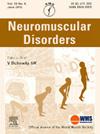361P Development of a next-generation multiplex ddPCR assay for measurement of in-frame dystrophin mRNA in people with DMD treated with BMN 351
IF 2.7
4区 医学
Q2 CLINICAL NEUROLOGY
引用次数: 0
Abstract
BMN 351, a next-generation antisense oligonucleotide (ASO), is being developed for the treatment of people with Duchenne muscular dystrophy (DMD) who have mutations amenable to exon 51 skipping. Out-of-frame dystrophin mRNA transcripts are converted by exon 51 skipping to in-frame, near-full–length, functional dystrophin transcripts. In-frame dystrophin mRNA expression is an early pharmacodynamic marker of BMN 351 activity. Current standard methods measure mRNA skipping by calculating the percentage of in-frame (exon skipped) dystrophin transcripts over total dystrophin transcripts. However, the relationship between exon skip percentage and dystrophin protein expression is unclear, as measurement of exon skip percentage does not account for reduced total dystrophin mRNA in DMD muscle. Here, we propose a novel assay strategy that quantifies functional in-frame dystrophin mRNA as a percentage of normal in-frame dystrophin transcripts from control muscle. This enhances the value of dystrophin mRNA measurements and better aligns with and predicts protein expression. Using in silico data mining and experimental verification, we identified both ubiquitously expressed and muscle-specific normalizer transcripts that can be measured in a multiplex ddPCR method with in-frame and total dystrophin mRNA. Ubiquitously expressed normalizers enable reporting of in-frame dystrophin mRNA levels normalized to total cellular content, compensating for varying RNA quantity and quality between samples. Muscle-specific normalizers provide insight into in-frame dystrophin mRNA expression per muscle cell in biopsies that may contain inflammatory infiltrate and adipocyte cells that vary with disease state and across individual biopsies. In this next-generation multiplex approach we propose a strategy to provide a more comprehensive and clinically relevant evaluation of mRNA expression that may be more predictive of functional dystrophin protein levels following ASO treatment for DMD.
361P 开发新一代多重 ddPCR 检测方法,用于测量接受 BMN 351 治疗的 DMD 患者的框架内肌萎缩蛋白 mRNA
BMN 351 是一种下一代反义寡核苷酸 (ASO),目前正被开发用于治疗杜氏肌营养不良症 (DMD) 患者,这些患者的基因突变适合外显子 51 跳越。框架外的肌营养不良蛋白 mRNA 转录本可通过第 51 号外显子跳转转换为框架内的、接近全长的功能性肌营养不良蛋白转录本。框架内肌营养不良蛋白 mRNA 的表达是 BMN 351 活性的早期药效学标志。目前衡量 mRNA 跳越的标准方法是计算框架内(外显子跳越)肌营养不良蛋白转录本占肌营养不良蛋白转录本总数的百分比。然而,外显子跳越百分比与肌营养不良蛋白表达之间的关系尚不清楚,因为测量外显子跳越百分比并不能解释 DMD 肌肉中肌营养不良蛋白 mRNA 总量减少的原因。在这里,我们提出了一种新的检测策略,以对照组肌肉中正常框架内肌营养不良蛋白转录本的百分比来量化功能性框架内肌营养不良蛋白 mRNA。这提高了肌营养不良蛋白 mRNA 测量的价值,并更好地与蛋白质表达相一致和预测蛋白质表达。通过硅学数据挖掘和实验验证,我们确定了泛在表达的和肌肉特异的归一化转录本,它们可以用多重 ddPCR 方法与框架内和总的肌营养不良蛋白 mRNA 一起测量。泛在表达的归一化转录本可以报告框架内肌营养不良蛋白 mRNA 水平与细胞总含量的归一化水平,从而弥补不同样本之间 RNA 数量和质量的差异。肌肉特异性归一化器能深入了解活检样本中每个肌肉细胞的框架内肌营养不良蛋白 mRNA 表达情况,活检样本中可能含有炎症浸润细胞和脂肪细胞,这些细胞随疾病状态和不同活检样本而变化。在这种下一代多重方法中,我们提出了一种策略,以提供更全面和临床相关的 mRNA 表达评估,这种评估可能更能预测 ASO 治疗 DMD 后的功能性肌营养蛋白水平。
本文章由计算机程序翻译,如有差异,请以英文原文为准。
求助全文
约1分钟内获得全文
求助全文
来源期刊

Neuromuscular Disorders
医学-临床神经学
CiteScore
4.60
自引率
3.60%
发文量
543
审稿时长
53 days
期刊介绍:
This international, multidisciplinary journal covers all aspects of neuromuscular disorders in childhood and adult life (including the muscular dystrophies, spinal muscular atrophies, hereditary neuropathies, congenital myopathies, myasthenias, myotonic syndromes, metabolic myopathies and inflammatory myopathies).
The Editors welcome original articles from all areas of the field:
• Clinical aspects, such as new clinical entities, case studies of interest, treatment, management and rehabilitation (including biomechanics, orthotic design and surgery).
• Basic scientific studies of relevance to the clinical syndromes, including advances in the fields of molecular biology and genetics.
• Studies of animal models relevant to the human diseases.
The journal is aimed at a wide range of clinicians, pathologists, associated paramedical professionals and clinical and basic scientists with an interest in the study of neuromuscular disorders.
 求助内容:
求助内容: 应助结果提醒方式:
应助结果提醒方式:


